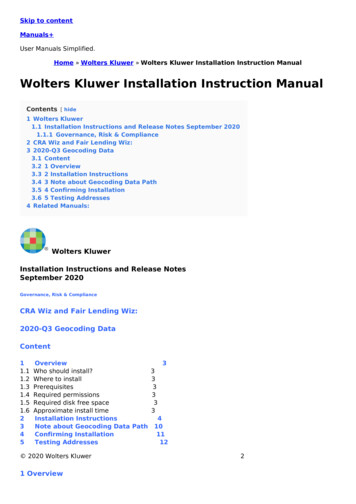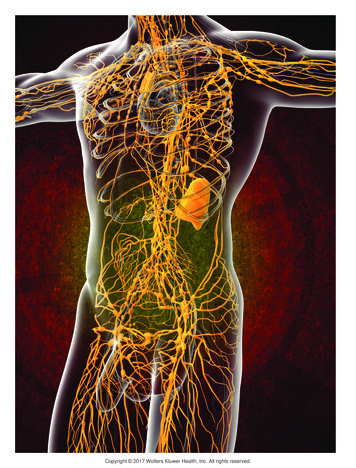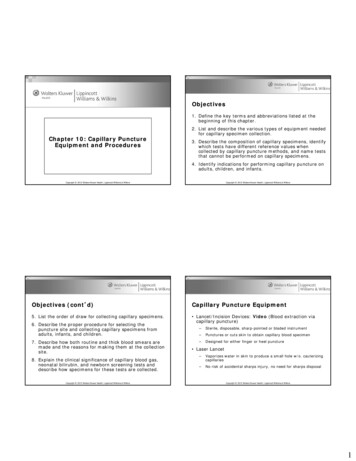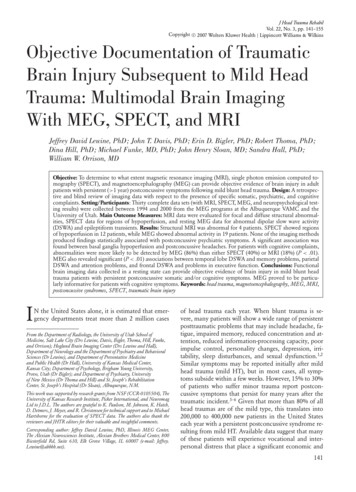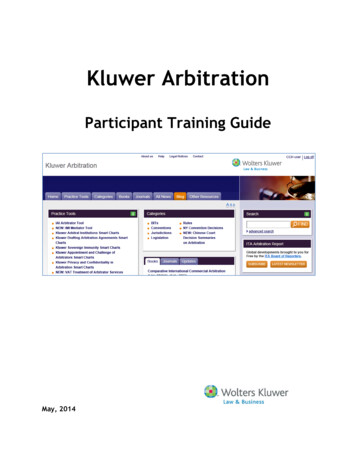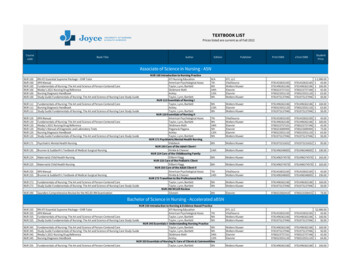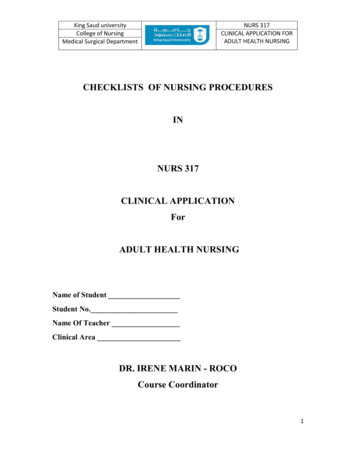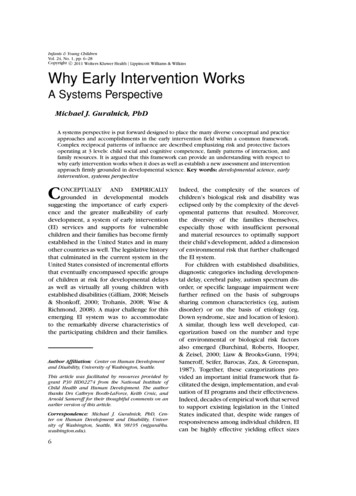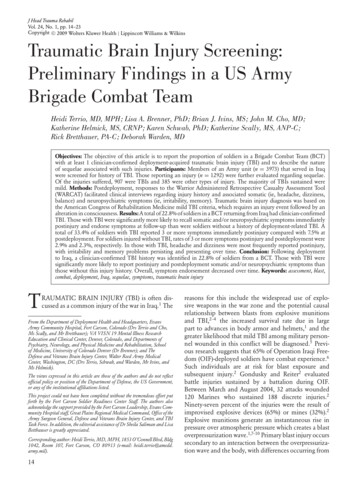
Transcription
J Head Trauma RehabilVol. 24, No. 1, pp. 14–23c 2009 Wolters Kluwer Health Lippincott Williams & WilkinsCopyright Traumatic Brain Injury Screening:Preliminary Findings in a US ArmyBrigade Combat TeamHeidi Terrio, MD, MPH; Lisa A. Brenner, PhD; Brian J. Ivins, MS; John M. Cho, MD;Katherine Helmick, MS, CRNP; Karen Schwab, PhD; Katherine Scally, MS, ANP-C;Rick Bretthauer, PA-C; Deborah Warden, MDObjectives: The objective of this article is to report the proportion of soldiers in a Brigade Combat Team (BCT)with at least 1 clinician-confirmed deployment-acquired traumatic brain injury (TBI) and to describe the natureof sequelae associated with such injuries. Participants: Members of an Army unit (n 3973) that served in Iraqwere screened for history of TBI. Those reporting an injury (n 1292) were further evaluated regarding sequelae.Of the injuries suffered, 907 were TBIs and 385 were other types of injury. The majority of TBIs sustained weremild. Methods: Postdeployment, responses to the Warrior Administered Retrospective Casualty Assessment Tool(WARCAT) facilitated clinical interviews regarding injury history and associated somatic (ie, headache, dizziness,balance) and neuropsychiatric symptoms (ie, irritability, memory). Traumatic brain injury diagnosis was based onthe American Congress of Rehabilitation Medicine mild TBI criteria, which requires an injury event followed by analteration in consciousness. Results: A total of 22.8% of soldiers in a BCT returning from Iraq had clinician-confirmedTBI. Those with TBI were significantly more likely to recall somatic and/or neuropsychiatric symptoms immediatelypostinjury and endorse symptoms at follow-up than were soldiers without a history of deployment-related TBI. Atotal of 33.4% of soldiers with TBI reported 3 or more symptoms immediately postinjury compared with 7.5% atpostdeployment. For soldiers injured without TBI, rates of 3 or more symptoms postinjury and postdeployment were2.9% and 2.3%, respectively. In those with TBI, headache and dizziness were most frequently reported postinjury,with irritability and memory problems persisting and presenting over time. Conclusion: Following deploymentto Iraq, a clinician-confirmed TBI history was identified in 22.8% of soldiers from a BCT. Those with TBI weresignificantly more likely to report postinjury and postdeployment somatic and/or neuropsychiatric symptoms thanthose without this injury history. Overall, symptom endorsement decreased over time. Keywords: assessment, blast,combat, deployment, Iraq, sequelae, symptoms, traumatic brain injuryTRAUMATIC BRAIN INJURY (TBI) is often discussed as a common injury of the war in Iraq.1 TheFrom the Department of Deployment Health and Headquarters, EvansArmy Community Hospital, Fort Carson, Colorado (Drs Terrio and Cho,Ms Scally, and Mr Bretthauer); VA VISN 19 Mental Illness ResearchEducation and Clinical Center, Denver, Colorado, and Departments ofPsychiatry, Neurology, and Physical Medicine and Rehabilitation, Schoolof Medicine, University of Colorado Denver (Dr Brenner); and TheDefense and Veterans Brain Injury Center, Walter Reed Army MedicalCenter, Washington, DC (Drs Terrio, Schwab, and Warden, Mr Ivins, andMs Helmick).The views expressed in this article are those of the authors and do not reflectofficial policy or position of the Department of Defense, the US Government,or any of the institutional affiliations listed.This project could not have been completed without the tremendous effort putforth by the Fort Carson Soldier Readiness Center Staff. The authors alsoacknowledge the support provided by the Fort Carson Leadership, Evans Community Hospital staff, Great Plains Regional Medical Command, Office of theArmy Surgeon General, Defense and Veterans Brain Injury Center, and TBITask Force. In addition, the editorial assistance of Dr Sheila Saliman and LisaBetthauser is greatly appreciated.Corresponding author: Heidi Terrio, MD, MPH, 1853 O’Connell Blvd, Bldg1042, Room 107, Fort Carson, CO 80913 (e-mail: heidi.terrio@amedd.army.mil).14reasons for this include the widespread use of explosive weapons in the war zone and the potential causalrelationship between blasts from explosive munitionsand TBI,2–4 the increased survival rate due in largepart to advances in body armor and helmets,1 and thegreater likelihood that mild TBI among military personnel wounded in this conflict will be diagnosed.5 Previous research suggests that 65% of Operation Iraqi Freedom (OIF)-deployed soldiers have combat experience.6Such individuals are at risk for blast exposure andsubsequent injury.2 Gondusky and Reiter2 evaluatedbattle injuries sustained by a battalion during OIF.Between March and August 2004, 32 attacks wounded120 Marines who sustained 188 discrete injuries.2Ninety-seven percent of the injuries were the result ofimprovised explosive devices (65%) or mines (32%).2Explosive munitions generate an instantaneous rise inpressure over atmospheric pressure which creates a blastoverpressurization wave.1,7–10 Primary blast injury occurssecondary to an interaction between the overpressurization wave and the body, with differences occurring from
Form ApprovedOMB No. 0704-0188Report Documentation PagePublic reporting burden for the collection of information is estimated to average 1 hour per response, including the time for reviewing instructions, searching existing data sources, gathering andmaintaining the data needed, and completing and reviewing the collection of information. Send comments regarding this burden estimate or any other aspect of this collection of information,including suggestions for reducing this burden, to Washington Headquarters Services, Directorate for Information Operations and Reports, 1215 Jefferson Davis Highway, Suite 1204, ArlingtonVA 22202-4302. Respondents should be aware that notwithstanding any other provision of law, no person shall be subject to a penalty for failing to comply with a collection of information if itdoes not display a currently valid OMB control number.1. REPORT DATE3. DATES COVERED2. REPORT TYPE200900-00-2009 to 00-00-20094. TITLE AND SUBTITLE5a. CONTRACT NUMBERTraumatic Brain Injury Screening: Preliminary Findings in a US ArmyBrigade Combat Team5b. GRANT NUMBER5c. PROGRAM ELEMENT NUMBER6. AUTHOR(S)5d. PROJECT NUMBER5e. TASK NUMBER5f. WORK UNIT NUMBER7. PERFORMING ORGANIZATION NAME(S) AND ADDRESS(ES)Heidi Terrio,MD,MPH,1853 O?Connell Blvd, Bldg 1042, Room107,Carson,CO,809139. SPONSORING/MONITORING AGENCY NAME(S) AND ADDRESS(ES)8. PERFORMING ORGANIZATIONREPORT NUMBER10. SPONSOR/MONITOR’S ACRONYM(S)11. SPONSOR/MONITOR’S REPORTNUMBER(S)12. DISTRIBUTION/AVAILABILITY STATEMENTApproved for public release; distribution unlimited13. SUPPLEMENTARY NOTES14. ABSTRACT15. SUBJECT TERMS16. SECURITY CLASSIFICATION OF:a. REPORTb. ABSTRACTc. THIS PAGEunclassifiedunclassifiedunclassified17. LIMITATION OFABSTRACT18. NUMBEROF PAGESSame asReport (SAR)1019a. NAME OFRESPONSIBLE PERSONStandard Form 298 (Rev. 8-98)Prescribed by ANSI Std Z39-18
Traumatic Brain Injury Screeningone organ system to another.8,9 In addition to injuries related to the barotrauma (primary blast injury), casualtiesmay be sustained from projectiles and related structuralcollapse (secondary blast injury) and from soldier bodily displacement (tertiary blast injury).1,2,4,9,11 Althoughresearch suggests that mechanical and blast-related injuries can occur in conjunction,11 less is known regardingthe relative contribution of each mechanism. Nevertheless, previous human and animal research suggests thatbarotrauma alone can be deleterious to the brain.2–4,11In studying survivors of the Balkan wars, Cernaket al3 identified patients with blast-related neurological injuries characterized by abnormal neurologicalexamination and electroencephalographic and neuroendocrine profiles. This finding was supported by a 2001animal study, which confirmed blast-induced neurotrauma with associated performance deficits.4Most civilian and military TBIs that occur aremild.12,13 The majority of individuals are not hospitalized for such injuries.13,14 One study analyzing surveydata from a representative sample of US civilian households found that 25% of those who reported sustaining head injury that resulted in unconsciousness didnot receive any medical assessment or treatment fortheir injury.14 Nevertheless, such injuries are not inconsequential. Although for most individuals recovery cantake up to 3 months,15 studies have estimated that between 7% and 33% of those who sustain a mild TBI havesymptoms that persist beyond this period of time.16A limited amount of epidemiologic data about Operation Enduring Freedom/Operation Iraqi Freedom TBIhave been published. One brief report focused on ahospitalized sample of more seriously injured patientstreated at the major Army referral hospital in the UnitedStates and, therefore, is not representative of those whosustained injuries and remained in theater.5 Anotherstudy used a cross-sectional anonymous questionnairemethodology to report on a sample of Army personnelwho had completed an assignment in Iraq approximately3 months previously.17 To date, little is known aboutthe incidence of clinician-confirmed TBI among militarypersonnel serving in Iraq and the associated symptomswhich may continue after soldiers’ return to their homebases. This is in part related to the fact that TBI assessment can be difficult in a combat setting, particularlyif medical systems are strained and/or the evaluationof non–life-threatening injuries is delayed.18 Data aboutthe incidence and outcomes of war-related TBI are necessary for determining the amount of burden TBI posesfor individual service members and the military so thateffective strategies for managing these TBI cases can bedeveloped.In both military and civilian populations, diagnosticchallenges are potentially increased if medical recordsregarding TBI history are inaccessible or care for injuries15was never sought.19 As such, structured or in-depth interviews confirming an alteration in consciousness in thecontext of an injury is currently accepted as the “goldstandard” for mild TBI diagnosis.19,20 Ideally, such interviews would be conducted by individuals with training in TBI, thereby allowing for increased diagnosticaccuracy.However, when assessing a large number of people, avalidated screening tool is desirable. Preliminary work inthis area has been completed by Schwab and colleagues18using a 1-page questionnaire called the Brief TraumaBrain Injury Screen (BTBIS). For soldiers returning fromIraq and/or Afghanistan, the consistency of TBI reporting across instruments, including the BTBIS, was analyzed. Eighty-three percent of those who were locatedfor follow-up interview and had self-reported alteredmental status consistent with TBI on the BTBIS provided details of the injury to the clinical interviewer thatconfirmed the mild TBI criteria. Furthermore, soldierswho screened positive on the BTBIS alone were as likelyduring the interview to provide injury details that wereconsistent with standard mTBI criteria as soldiers whoscreened positive for TBI on the BTBIS on one or bothof the longer questionnaires.During the Post-Deployment Health Assessment(PDHA), returning military personnel complete a questionnaire designed to gather information about theirpresent health status, as well as their exposure, while deployed, to numerous illness-producing risk factors suchas combat stress and environmental hazards. Days afterreturning to their home bases from a deployment overseas, all military personnel are required to participate inthis process. Since June of 2005, the PDHA evaluationprocess at Fort Carson has included screening for mildTBI. Toward this end, soldiers complete a brief questionnaire, which is used to facilitate an interview by amultidisciplinary team of clinicians.This article presents findings from a retrospective analysis of TBI-specific data gathered with a questionnaire,21the Warrior Administered Retrospective Casualty Assessment Tool (WARCAT), and confirmed by clinical interview. At Fort Carson, the combination of theWARCAT and clinical interview are referred to as theWARCAT Plus. The PDHA was performed at FortCarson, Colorado, with a US Army brigade combat team(BCT) that served 1 year (2004–2005) in Iraq. This articlepresents the proportion of soldiers in this BCT returning from deployment who sustained at least 1 clinicianconfirmed TBI, with those reporting an injury (non-TBI)as the comparison group. Some soldiers (eg, those whowere medically evacuated or had left the army) were notincluded in the presented sample. Related somatic (ie,headache, dizziness, balance problems) and neuropsychiatric (ie, irritability, memory problems) symptoms atthe time of injury and at PDHA are reported.www.headtraumarehab.com
16JOURNAL OF HEAD TRAUMA REHABILITATION/JANUARY–FEBRUARY 2009METHODSParticipantsAll members of 1 US Army BCT (n 3973) whoreturned to Fort Carson, Colorado, from a 1-year deployment in Iraq were administered the WARCAT during their PDHA. It was the unit’s first deployment to acombat zone during the present conflict. Soldiers witha clinician-confirmed injury event (n 1292) receivedfurther screening regarding sequelae. Members of thisgroup included those with at least 1 combat-acquiredTBI (n 907) and those with an injury event but noTBI (n 385).InstrumentThe WARCAT,21 based on the BTBIS,18 was developed at Fort Carson. Soldiers completed the questionnaire indicating whether they were injured frommechanisms commonly associated with TBI while deployed, whether any injuries resulted in an altered mental status indicative of TBI, and/or whether specificsomatic and neuropsychiatric symptoms commonlyassociated with mild TBI occurred after the injury(immediately postinjury and/or postdeployment). Thesomatic and neuropsychiatric symptoms were not usedto make the diagnosis of TBI but rather to determine the frequency of sequelae between groups of injured soldiers with and without TBI. Specific symptoms queried included headaches, dizziness, memoryproblems, balance problems, and irritability. Items regarding 2 other symptoms, ringing in the ears andsleep problems, were also on the questionnaire butwere not included in the presented analysis secondaryto their expected frequency among returning combatSoldiers.were thought to increase the likelihood that the individual had also sustained a TBI (eg, ruptured eardrums),the Soldier Readiness Center (SRC) clinicians queriedregarding a potential combat-related TBI history regardless of the Soldier’s initially endorsed responses. If discrepancies existed between results of the WARCAT andthe interview questionnaire responses were changed tobe reflective of clinicians’ findings. All soldiers had atleast one SRC Clinical interview.The design of the WARCAT did not allow for the injury mechanism to be directly associated with the historyof TBI. Questions regarding injury events and alterationin consciousness were not linked. That is, although clinicians did confirm the history of TBI and made changesas indicated on the WARCAT, they were not instructedto note specific dates by injury event(s). As a result, ifthe soldier sustained multiple injuries it was not possibleto clarify the particular mechanism of injury responsiblefor the TBI.The above-described process combined the advantages of a self-report survey, clinical interview, and collateral information for identifying individuals with TBI,which may not have been previously recognized. In theend, WARCAT Plus injury and sequelae data were usedin analyses. Demographic and military characteristicswere obtained from a separate database, Army MedicalSurveillance Activity.All soldiers diagnosed with clinician-confirmeddeployment-related TBI were provided with educationalmaterials regarding mild TBI,21 including the expectancyof recovery and strategies to decrease distress during therecovery period. Individuals who were experiencing anytype of health problem, regardless of whether or not theyhad a TBI, were referred to the appropriate healthcareproviders for further assessment and treatment.ProceduresANALYSISAfter completing the WARCAT, all soldiers hadat least one interview with a clinician. Master’s- anddoctoral-level providers who had received training inTBI queried soldiers to clarify whether they had sustained an alteration in consciousness in the context ofan injury. This definition of mild TBI is consistent withthat articulated by the American Congress of Rehabilitation Medicine.22 During the interview, the WARCATand all available medical records (eg, from deployment)were reviewed. The clinicians also confirmed the details of the injury event (eg, distance from explosives,whether the helmet stayed on, whether others were injured in the incident). Collateral information from battlebuddies obtained by clinicians confirming the recalledhistory of the injury event and the possible alterationin consciousness was also used. Moreover, if during thecourse of the PDHA other injuries were identified thatThis analysis was approved by the Brooke Army Medical Center Clinical Institutional Review Board. Chisquare tests were used to compare data for those withand without TBI. The analysis regarding time since injury was conducted using a student’s t test. Data are reported as means, standard deviations, and percentages,as appropriate. The analyses of somatic and neuropsychiatric symptoms included 5 TBI-related symptoms:headache, dizziness, balance problems, irritability, andmemory problems. Multiple logistic regression was usedto examine the effect of TBI status on having 1 or moremild TBI symptom immediately after injury and afterreturning from deployment while controlling for demographic and military characteristics (ie, gender, age,education, rank, and military occupational specialty).Injured soldiers for whom any demographic or militarycharacteristics were unknown were excluded from the
Traumatic Brain Injury ScreeningTABLE 1Screening results Injury statusInjured with TBIInjured without TBINot injuredTotal ScreenedInjury characteristics for thosewith TBI†Dazed or confused onlyHad loss of consciousness or couldnot remember the injuryTotal with TBI907 (22.8)385 (9.7)2681 (67.5)3973 (100)572 (63.1)335 (36.9)907 (100) Values represent n (%). TBI indicates traumatic brain injury.TBI is defined as an injury event followed by an alteration in consciousness such as being dazed or confused, not remembering theinjury event, and/or losing consciousness.†logistic regression analyses. All independent variableswere entered together. Categorical independent variableswith more than 2 categories, such as education, age, andrank, were initially entered into the regression models ascovariates to measure their overall effect on symptomrisk. If a categorical variable with more than 2 categorieswas associated with symptom status in the initial analysis, the analysis was repeated with that variable enteredas a categorical variable to identify the specific categoriesthat were associated with symptoms.RESULTSUsing the WARCAT Plus, the combination of the selfreport and clinical assessment, 907 soldiers (22.8%) werediagnosed with a deployment TBI (Table 1). An additional 385 soldiers (9.7%) reported an injury but did notreport a history consistent with TBI (ie, no alteration inconsciousness). Injury characteristics of those with TBIare presented in Table 1. Blast was the most frequentlyreported injury mechanism (88.0%) by soldiers screening positive for TBI, followed by vehicular (39.0%), fall(20.0%), fragment (15.8%), and bullet (3.1%). Becausesome soldiers reported sustaining their injuries via multiple mechanisms, the percentages total more than 100.A limited number of soldiers provided a date of mostserious injury. In the TBI group (n 338 of 907), therewas no significant difference in months since injury forthose denying (mean 5.6, SD 3.4; n 131) versusendorsing (mean 5.9, SD 3.2; n 207) (P .965)at least 1 symptom at the PDHA. The time since injurywould not be greater than 12 months, since this was thelength of the deployment and the screening occurreddays after returning home.Demographic and military characteristics of BCT soldiers by injury status are presented in Table 2. Data inTable 3 indicate that soldiers sustaining an alteration17in consciousness during at least 1 injury event (deployment TBI) were significantly more likely to recall somatic and/or neuropsychiatric symptoms immediatelypostinjury and at follow-up than soldiers who had noalteration in consciousness during any of their injuryevents (no deployment TBI).Multiple logistic regression analyses showed thatclinician-confirmed TBI history was a significant predictor of mild TBI symptom status immediately afterinjury (adjusted OR 35.2, P .001) and after returning from deployment (adjusted OR 5.1, P .001)when controlling for demographic and military characteristics (Table 4). The omnibus χ 2 tests for both modelswere statistically significant (P .001). Rank was theonly other predictor of symptom status immediately after injury (adjusted OR 1.4, P .048), whereas agewas the only other predictor of symptom status afterreturning from deployment (adjusted OR 1.2, P .018) (Table 4). Subsequent regression analysis of theeffect of rank on symptom risk immediately after injury showed that only 1 category, senior noncommissioned officer (NCO), was associated with increasedsymptoms (adjusted OR 3.4, P .021). No otherrank category was associated with symptom risk. A subsequent regression analysis of the effect of age on symptom risk after returning from deployment showed thatthe 25 to 29 age category was associated with increasedsymptom risk after returning from deployment (adjustedOR 1.6, P .011). The association between the 30 to39 age category and symptom risk trended toward significance (adjusted OR 1.5, P .056). No other age category was associated with symptom risk. Military occupational specialty, gender, and education did not emergeas significant predictors of symptom status at either timeperiod.Change in the number of symptoms reported at injuryand PDHA by soldiers with TBI is presented in Table 5.Table 6 shows the occurrence of specific mild TBI–related symptoms among soldiers determined to havea TBI, at 2 timeframes, right after the injury and after returning from deployment. The course of specific symptoms among soldiers with TBI is provided inTable 7.DISCUSSIONResults from the current study indicate that 907(22.8%) individuals from an Army unit had at least 1clinician-confirmed TBI, most of which were mild innature (Table 1). The most common mechanism of injury was blast, at 88%. Data in Table 3 show that thosesoldiers sustaining an injury event causing an alterationin consciousness (deployment TBI) were significantlymore likely to recall targeted somatic and/or neuropsychiatric mTBI symptoms immediately postinjury and atwww.headtraumarehab.com
18TABLE 2JOURNAL OF HEAD TRAUMA REHABILITATION/JANUARY–FEBRUARY 2009Demographic and military characteristics by injury status Age, y18–2425–2930–39 �No high school diplomaHigh school graduateSome collegeCollege graduateUnknownMilitary rank‡Junior enlistedMid-level noncommissioned officersSenior noncommissioned officersWarrant and commissioned officersUnknownMilitary occupational specialty†,‡CombatCombat support (eg, engineer)Support (eg, cook)UnknownNot injured (%)(n 2681)Injured without TBI (%)(n 385)Injured with TBI (%)(n 3.041.327.828.12.954.525.818.01.8*TBI indicates traumatic brain injury.† Difference between TBI group and injured without TBI group is statistically significant, P .05.‡ Difference between TBI group and not injured group is statistically significant, P .05.follow-up than Soldiers who had no alteration in consciousness during any of their injury events (no deployment TBI). The percentage of soldiers with TBI whoreported 1 or more symptoms decreased dramatically(92.0% vs. 38.9%) from the time of injury to the time theBCT returned from Iraq (Table 3). Of note, 33.4% of soldiers with TBI reported 3 or more symptoms postinjuryand 7.5% of soldiers with TBI reported 3 or more symptoms postdeployment. This is in comparison to thosewithout TBI, of whom 2.9% reported 3 or more symptoms postinjury and 2.3% reported 3 or more symptomspostdeployment.Multiple logistic regression analysis indicated thathaving a TBI was a risk factor for symptoms immediatelyafter injury (adjusted OR 35.2, P .001) and after returning from deployment (adjusted OR 5.1, P .001)when controlling for demographic and military characteristics (Table 4). Only 1 rank category, senior NCOs,emerged as a risk factor for symptoms immediately afterinjury. This may be an anomaly because this category issmall (about 6% of cases analyzed) and no other rankcategory was associated with increased symptom risk.The association between symptom risk and age appearsto be stronger. One age category (25–29) emerged as anadditional risk factor for symptoms after returning fromdeployment and this category comprised a larger proportion of the cases analyzed (about 25%) than the seniorNCO category. The association between symptom riskafter returning from deployment and another age category (30–39) trended toward significance and this wasalso a larger category than the senior NCO category.In this data set, military occupational specialty did notemerge as a predictor of mild TBI symptom status ateither time period.Because of the fact that the WARCAT focused on thepresence or absence of common TBI sequelae, and notsymptom severity or the relationship between symptomsreported and psychosocial functioning, the impact ofeither individual or clusters of symptoms is unknown.On the basis of existing definitions only soldiersendorsing 3 or more symptoms would meet criteria forpost–acute syndromes or disorders related to a history
Traumatic Brain Injury Screening19Number of injured soldiers with mild TBI symptoms by injury status and timesince injury†TABLE 3n (%)Injured with TBI (n 907)Injured without TBI (n 385)Number of mild TBI symptoms right after injury0123 or moreTotal With 1 or More Symptoms‡Total With 2 or More Symptoms‡72 (7.9)246 (27.1)286 (31.5)303 (33.4)835 (92.0)589 (64.9)283 (73.5)67 (17.4)24 (6.2)11 (2.9)102 (26.5)35 (9.1)Number of mild TBI symptoms after returning tothe United States from deployment0123 or moreTotal With 1 or More Symptoms‡Total With 2 or More Symptoms‡554 (61.1)193 (20.2)102 (11.2)68 (7.5)353 (38.9)170 (18.7)341 (88.6)26 (6.8)9 (2.3)9 (2.3)44 (11.4)18 (4.6) MildTBI symptoms: headache, dizziness, balance problems, memory problems, and irritability.indicates traumatic brain injury.‡ Difference between soldiers with and without TBI is statistically significant, P .001.† TBILogistic regression results showing combined effects of TBI status and demographic and military characteristics on having 1 or more mild TBI symptoms amonginjured soldiers with and without TBI (n 1208) ,†TABLE 4VariableParameterestimate (ββ)SE βWaldHad 1 or more mild TBI symptoms after injury‡TBI status3.5610.182383.141Gender 0.4560.5870.604Age 0.0310.1170.068Education 0.1490.1920.606Rank0.3030.1533.992Military occupational specialty0.1320.1151.331Constant 0.056Had 1 or more mild TBI symptoms after returning from deployment§TBI status1.6250.18576.993Gender 0.1720.6980.061Age0.2130.0905.623Education 0.2090.1491.979Rank 0.1360.1191.319Military occupational specialty0.0390.0850.204Constant 1.338PAdjustedodds ratio95% CI adjustedodds 1–1.1010.879–1.229*TBI indicates traumatic brain injury.† Eighty-four injured soldiers were excluded because of unknown demographic or military characteristics.‡ Omnibus χ 2 542.998, P .000.§ Omnibus χ 2 113.106, P .000.www.headtraumarehab.com
20JOURNAL OF HEAD TRAUMA REHABILITATION/JANUARY–FEBRUARY 2009of brain injury.23,24 Further research aimed at clarifyingthe impact of specific symptoms based on severity (eg,debilitating headaches) is warranted.Soldiers in the Combat Arms Branches were morelikely to sustain a TBI (Table 2). We also note that 44%of TBIs occurred in soldiers participating in combat support or support occupational specialties. Thus, a fluidbattlefield and lack of a defined front places all soldiersat risk.Headache (81.3%) and dizziness (59.3%) were identified as being the predominant symptoms immediatelyafter injury (Table 6). These findings are consistent withprevious research.25,26 According to the World HealthOrganization Collaborating Centre Task Force on mildTBI, there is consistent evidence that adults experienceheadaches in the acute stage and months followingTBI.25 In collegiate football players who sustained concussions, headache was the most commonly reportedsymptom at the time of injury (85.2%) followed byproblems with balance/dizziness.26 In returning soldiers, symptoms that most frequently resolved by timeof postdeployment included dizziness (93.7%), balanceproblems (84.7%), and headaches (77.3%) (Table 7). Although a number of soldiers denied memory problemsand irritability in the acute stage, 52.3% and 48.6%,respectively, endorsed such symptoms postdeployment(Table 7). The later onset of memory problems andirritability may be related to challenges that arise as individuals return home. In addition, increases in neuropsychiatric symptoms (eg, verbal aggression and depression)over time have been previ
Report Documentation Page Form Approved OMB No. 0704-0188 Public reporting burden for the collection of information is estimated to average 1 hour per response, including the time for reviewing instructions, searching existing data sources, gathering and
